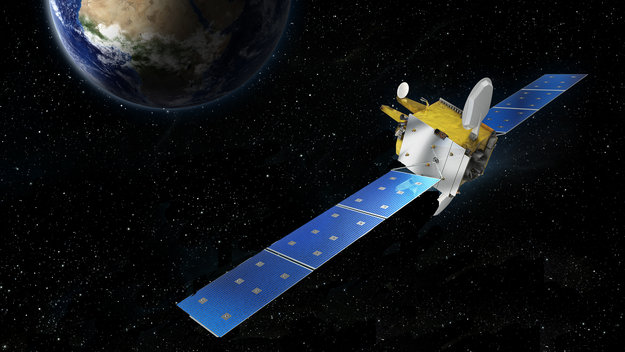GIOVE-A Uses GPS Side Lobe Signals for Far-Out Space Navigation
The European Space Agency’s (ESA’s) retired GIOVE-A navigation mission has become the first civilian satellite to perform GPS position fixes from high orbit. Its results demonstrate that current satnav signals could guide missions much further away in space, up to geostationary orbit or even as far as the Moon.
GIOVE-A has been able to fix its position, velocity and time from GPS signals, despite orbiting more than 1000 km above the downward-pointing U.S. satellites.
“Satellite navigation has become almost as indispensable for most low-orbiting satellites as it is for car drivers and other terrestrial users,” said ESA’s Steeve Kowaltschek. “Satellites equipped with satnav receivers can continuously monitor their orbit in space, enabling largely autonomous operations with limited ground intervention. GIOVE-A’s three months of data show that future geostationary satellites could operate in the same way, bringing real competitive advantage to the multi-billion-euro telecommunications satellite market.”
Launched in 2005 to claim radio frequencies and test hardware for Europe’s Galileo satnav constellation, the Galileo In-Orbit Validation Element-A, or GIOVE-A, mission far outlasted its original two-year design life. It was formally decommissioned by ESA in the middle of last year, once the first Galileo satellites completed their orbital commissioning. Having been moved into a graveyard orbit about 100 km above Galileo’s orbital altitude of 23 222 km, control was passed to its prime contractor Surrey Satellite Technology Ltd. of Guildford, UK.
ESA had originally worked with SSTL to customize one of the company’s existing satnav receivers for testing on GIOVE-A, an activity supported through ESA’s Advanced Research in Telecommunications Systems (ARTES) program. In the event, the satnav receiver was activated for only 90 minutes during the very beginning of the satellite’s seven-year operational life, with GIOVE-A’s main tasks given priority. Once the formal mission was over, ESA and SSTL took the opportunity to switch the receiver on again.
“We have been really encouraged by the initial results from our receiver,” said Martin Unwin at SSTL. “Our patience has finally been rewarded, and we would like to make the best of this unique opportunity.”
SSTL is able to upload new software to the receiver in orbit, and has been able to apply sophisticated software algorithms to help detect faint satnav signals. Further work is planned to refine operation through the use of an accurate onboard clock and orbit-estimating algorithms.

GIOVE-A has been able to make use of signals emitted sideways from GPS antennas, within what is known as side lobes.
GPS Side Lobes. GPS satellites — like those of Galileo, Russia’s Glonass or their Japanese, Chinese and Indian counterparts — aim their antennas directly at Earth. Any satellite orbiting above the GPS constellation can only hope to detect signals from over Earth’s far side, but the majority are blocked by the planet. For a position fix, a satnav receiver requires a minimum of four satellites to be visible, but this is most of the time not possible if based solely on front-facing signals.
Instead, GIOVE-A makes use of signals emitted sideways from GPS antennas, within what is known as side lobes. Just like a flashlight, radio antennas shine energy to the side as well as directly forward.
“These side lobes are not typically well measured because this is energy that doesn’t reach users on Earth,” explained Kowaltschek. “Antenna designers seek to minimize them, but the laws of physics mean they will always be present in some form. Measuring these GPS side lobes has shown them to be stronger than anticipated, and the combination of side lobes and signals spilling over from the other side of Earth mean that a position fix can be maintained throughout GIOVE-A’s orbit.”
The satellite has also acquired detailed profiles of the signal side-lobe characteristics of the various GPS design blocks.
Geostationary satellites reside in set orbital slots, some 80-km across, up in the 36,000-km-altitude belt. Chemical thruster firings are needed every fortnight or so to correct for drift, checked against radio ranging from the ground.
Harnessing satnav would be a way of automating station-keeping functions. It also meshes with the current move to all-electric comsat designs, such as ESA’s Electra. Electric propulsion would do the job of conventional chemical thrusters, delivering more compact satellites capable of flying on cheaper launch vehicles while offering longer mission lifetimes. But electric propulsion provides lower thrust and therefore requires almost permanent ground ranging. Continuous position fixes via satnav could perform this task onboard, maintaining the orbit position with better accuracy.
In addition, constant orbit determination and close-to-perfect time knowledge also improves pointing accuracy on comsats that use startrackers as their main attitude sensor.
All-electric comsats using satnav could gradually steer themselves up to geostationary orbit following launch, further slashing the required launcher size, onboard fuel and ground support.
“We envisage a future satnav receiver that can track not only GPS, but also Galileo and Glonass signals at high altitudes, meaning a near-continuous availability of accurate position and time for geostationary and other satellites,” says Martin.
As a next step, a receiver will be flown on ESA’s SmallGEO telecom mission, due for launch in 2014. Building on the positive results of the GIOVE-A experiments, SmallGEO will be the first civilian mission to use satnav in geostationary orbit.

















Follow Us